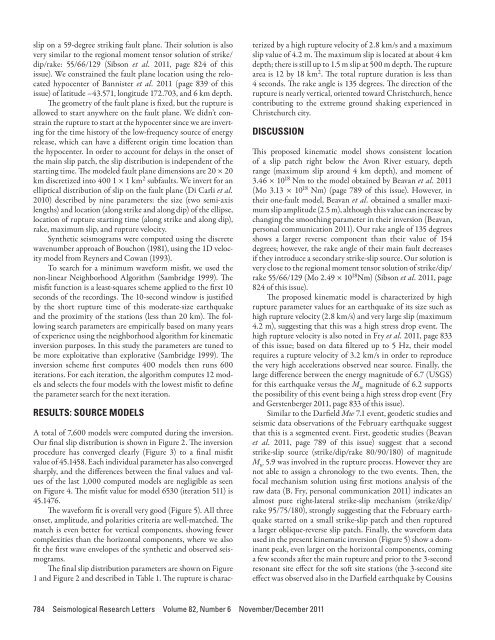Here - Stuff
Here - Stuff
Here - Stuff
You also want an ePaper? Increase the reach of your titles
YUMPU automatically turns print PDFs into web optimized ePapers that Google loves.
slip on a 59-degree striking fault plane. Their solution is alsovery similar to the regional moment tensor solution of strike/dip/rake: 55/66/129 (Sibson et al. 2011, page 824 of thisissue). We constrained the fault plane location using the relocatedhypocenter of Bannister et al. 2011 (page 839 of thisissue) of latitude –43.571, longitude 172.703, and 6 km depth.The geometry of the fault plane is fixed, but the rupture isallowed to start anywhere on the fault plane. We didn’t constrainthe rupture to start at the hypocenter since we are invertingfor the time history of the low-frequency source of energyrelease, which can have a different origin time location thanthe hypocenter. In order to account for delays in the onset ofthe main slip patch, the slip distribution is independent of thestarting time. The modeled fault plane dimensions are 20 × 20km discretized into 400 1 × 1 km 2 subfaults. We invert for anelliptical distribution of slip on the fault plane (Di Carli et al.2010) described by nine parameters: the size (two semi-axislengths) and location (along strike and along dip) of the ellipse,location of rupture starting time (along strike and along dip),rake, maximum slip, and rupture velocity.Synthetic seismograms were computed using the discretewavenumber approach of Bouchon (1981), using the 1D velocitymodel from Reyners and Cowan (1993).To search for a minimum waveform misfit, we used thenon-linear Neighborhood Algorithm (Sambridge 1999). Themisfit function is a least-squares scheme applied to the first 10seconds of the recordings. The 10-second window is justifiedby the short rupture time of this moderate-size earthquakeand the proximity of the stations (less than 20 km). The followingsearch parameters are empirically based on many yearsof experience using the neighborhood algorithm for kinematicinversion purposes. In this study the parameters are tuned tobe more exploitative than explorative (Sambridge 1999). Theinversion scheme first computes 400 models then runs 600iterations. For each iteration, the algorithm computes 12 modelsand selects the four models with the lowest misfit to definethe parameter search for the next iteration.RESULTS: SOURCE MODELSA total of 7,600 models were computed during the inversion.Our final slip distribution is shown in Figure 2. The inversionprocedure has converged clearly (Figure 3) to a final misfitvalue of 45.1458. Each individual parameter has also convergedsharply, and the differences between the final values and valuesof the last 1,000 computed models are negligible as seenon Figure 4. The misfit value for model 6530 (iteration 511) is45.1476.The waveform fit is overall very good (Figure 5). All threeonset, amplitude, and polarities criteria are well-matched. Thematch is even better for vertical components, showing fewercomplexities than the horizontal components, where we alsofit the first wave envelopes of the synthetic and observed seismograms.The final slip distribution parameters are shown on Figure1 and Figure 2 and described in Table 1. The rupture is characterizedby a high rupture velocity of 2.8 km/s and a maximumslip value of 4.2 m. The maximum slip is located at about 4 kmdepth; there is still up to 1.5 m slip at 500 m depth. The rupturearea is 12 by 18 km 2 . The total rupture duration is less than4 seconds. The rake angle is 135 degrees. The direction of therupture is nearly vertical, oriented toward Christchurch, hencecontributing to the extreme ground shaking experienced inChristchurch city.DISCUSSIONThis proposed kinematic model shows consistent locationof a slip patch right below the Avon River estuary, depthrange (maximum slip around 4 km depth), and moment of3.46 × 10 18 Nm to the model obtained by Beavan et al. 2011(Mo 3.13 × 10 18 Nm) (page 789 of this issue). However, intheir one-fault model, Beavan et al. obtained a smaller maximumslip amplitude (2.5 m), although this value can increase bychanging the smoothing parameter in their inversion (Beavan,personal communication 2011). Our rake angle of 135 degreesshows a larger reverse component than their value of 154degrees; however, the rake angle of their main fault decreasesif they introduce a secondary strike-slip source. Our solution isvery close to the regional moment tensor solution of strike/dip/rake 55/66/129 (Mo 2.49 × 10 18 Nm) (Sibson et al. 2011, page824 of this issue).The proposed kinematic model is characterized by highrupture parameter values for an earthquake of its size such ashigh rupture velocity (2.8 km/s) and very large slip (maximum4.2 m), suggesting that this was a high stress drop event. Thehigh rupture velocity is also noted in Fry et al. 2011, page 833of this issue; based on data filtered up to 5 Hz, their modelrequires a rupture velocity of 3.2 km/s in order to reproducethe very high accelerations observed near source. Finally, thelarge difference between the energy magnitude of 6.7 (USGS)for this earthquake versus the M w magnitude of 6.2 supportsthe possibility of this event being a high stress drop event (Fryand Gerstenberger 2011, page 833 of this issue).Similar to the Darfield Mw 7.1 event, geodetic studies andseismic data observations of the February earthquake suggestthat this is a segmented event. First, geodetic studies (Beavanet al. 2011, page 789 of this issue) suggest that a secondstrike-slip source (strike/dip/rake 80/90/180) of magnitudeM w 5.9 was involved in the rupture process. However they arenot able to assign a chronology to the two events. Then, thefocal mechanism solution using first motions analysis of theraw data (B. Fry, personal communication 2011) indicates analmost pure right-lateral strike-slip mechanism (strike/dip/rake 95/75/180), strongly suggesting that the February earthquakestarted on a small strike-slip patch and then ruptureda larger oblique-reverse slip patch. Finally, the waveform dataused in the present kinematic inversion (Figure 5) show a dominantpeak, even larger on the horizontal components, cominga few seconds after the main rupture and prior to the 3-secondresonant site effect for the soft site stations (the 3-second siteeffect was observed also in the Darfield earthquake by Cousins784 Seismological Research Letters Volume 82, Number 6 November/December 2011
















